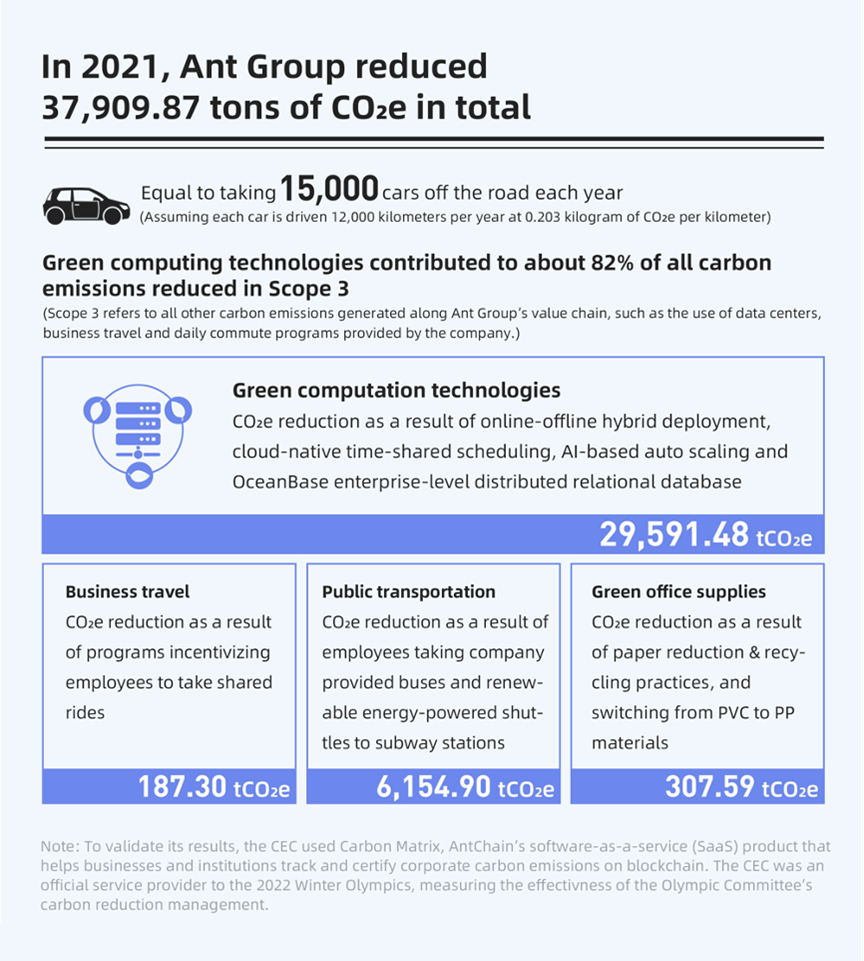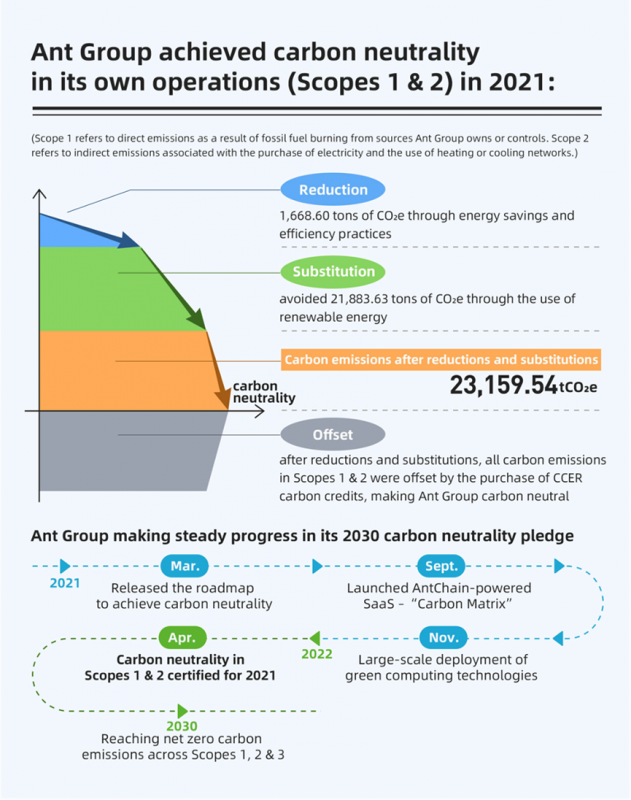Ant Group today announced it has achieved carbon neutrality in its own operations (Scopes 1 & 2), according to 2021 emission figures certified by the China Environmental United Certification Center (CEC). This marks the Company’s first major step towards fulfilling the commitments it made in March 2021 to achieve net zero in carbon emissions by 2030, including providing periodic updates on its progress towards achieving this important goal.
According to CEC certified figures, in 2021, Ant Group reduced a total of 37,909.87 tons of CO2e, equivalent to taking 15,000 cars off the road each year, assuming each car is driven 12,000 kilometers per year at 0.203 kilogram of CO2e per kilometer.
To validate its results, the CEC used Carbon Matrix, AntChain’s software-as-a-service (SaaS) product that helps businesses and institutions track and certify corporate carbon emissions on blockchain. The CEC was an official service provider to the 2022 Winter Olympics, measuring the Olympic Committee’s carbon reduction effectiveness.
In 2021, Ant Group achieved carbon neutrality in its own operations (Scopes 1 & 2) through a combination of reductions, substitutions and offsets:
- Reduction: reduced 1,668.60 tons of CO2e by improving its energy savings and efficiency practices.
- Substitution: avoided 21,883.63 tons of CO2e through the use of renewable energy.
- Offset: offset 23,159.54 tons of CO2e through the purchase of China Certified Emission Reductions (CCERs).
“This is a major milestone since we announced our carbon neutrality goal on March 12, 2021,” said Yijie Peng, Vice President of Ant Group. “Leveraging innovative technologies such as blockchain and green computation, we are well underway to achieve an inclusive, green and sustainable future.”
According to Ant Group’s carbon neutrality roadmap, by 2030, the Company will achieve net zero carbon emissions across Scopes 1, 2 and 3. Scope 1 refers to direct emissions as a result of fossil fuel burning from sources Ant Group owns or controls. Scope 2 refers to indirect emissions associated with the purchase of electricity and the use of heating or cooling networks. Scope 3 refers to all other carbon emissions generated along Ant Group’s value chain, such as the use of data centers, business travel and daily commute programs provided by the Company.
In 2021, Ant Group reduced a total of 36,241.27 tons of CO2e in Scope 3, of which the adoption of green computing technologies contributed to 29,591.48 tons – or about 82% of all the Scope 3 reduction.
Data centers, which are at the core of today’s digital economy, consume a large amount of electricity and generate considerable carbon emissions. Following the adoption of green computing technologies in 2019 – such as online-offline hybrid deployment, cloud-native time-shared scheduling, AI-based auto scaling and OceanBase enterprise-level distributed relational database – Ant Group more than doubled the utilization rates of data servers in three years, while meaningfully reducing its carbon footprint.
Ant Group’s remaining Scope 3 carbon emission reductions came from sourcing environmentally friendly office supplies, and encouraging employees to take public transportation or shared rides – including taxis and carpooling for local business travel.
The CEC’s carbon neutrality certificate for Ant Group (in Chinese language only) is publicly available on the Information Platform for Carbon Neutrality, which is affiliated with the Environmental Development Center of China’s Ministry of Ecology and Environment.
About Ant Group
Ant Group aims to create the infrastructure and platform to support the digital transformation of the service industry. It strives to enable all consumers and small and micro businesses to have equal access to financial and other services that are inclusive, green and sustainable.
For more information, please visit our website at www.antgroup.com or follow us on Twitter @AntGroup.
Source: FAQ

